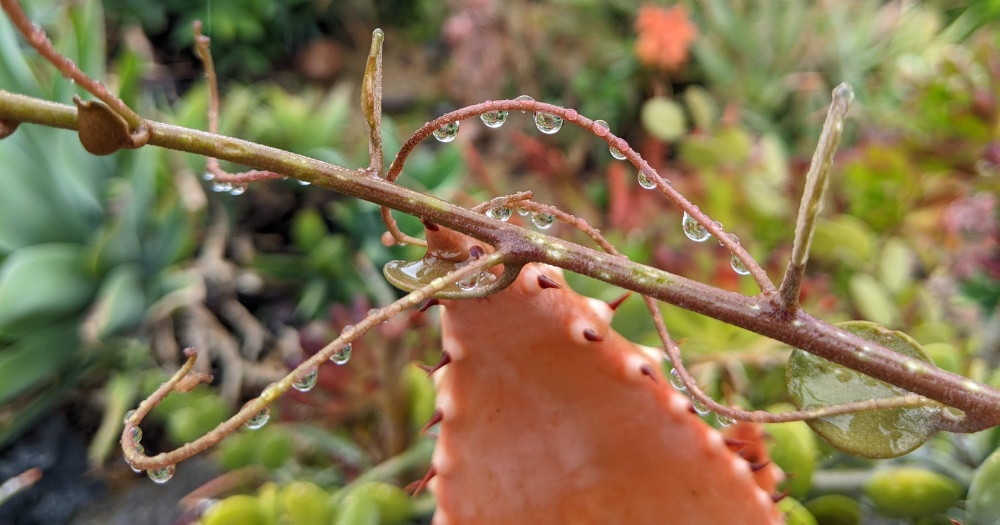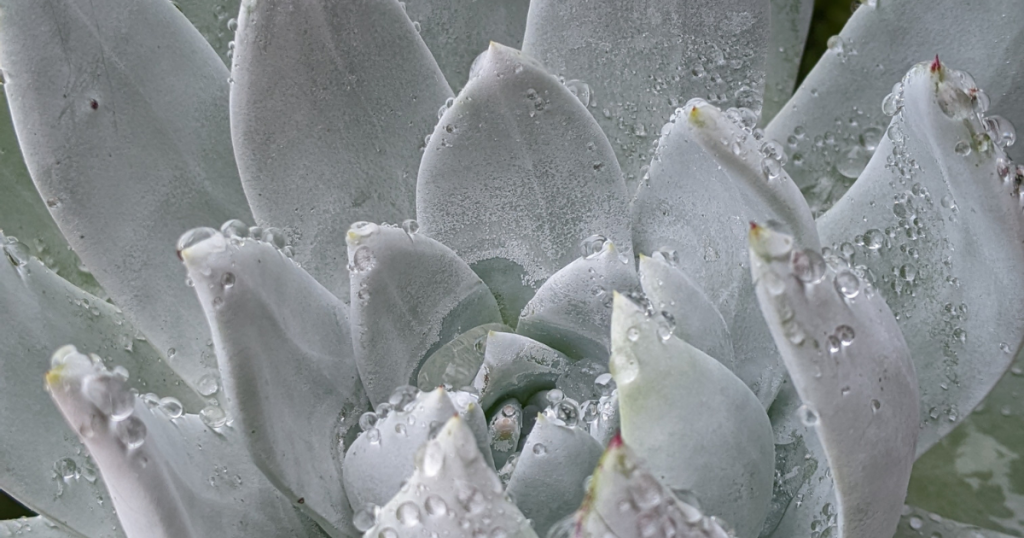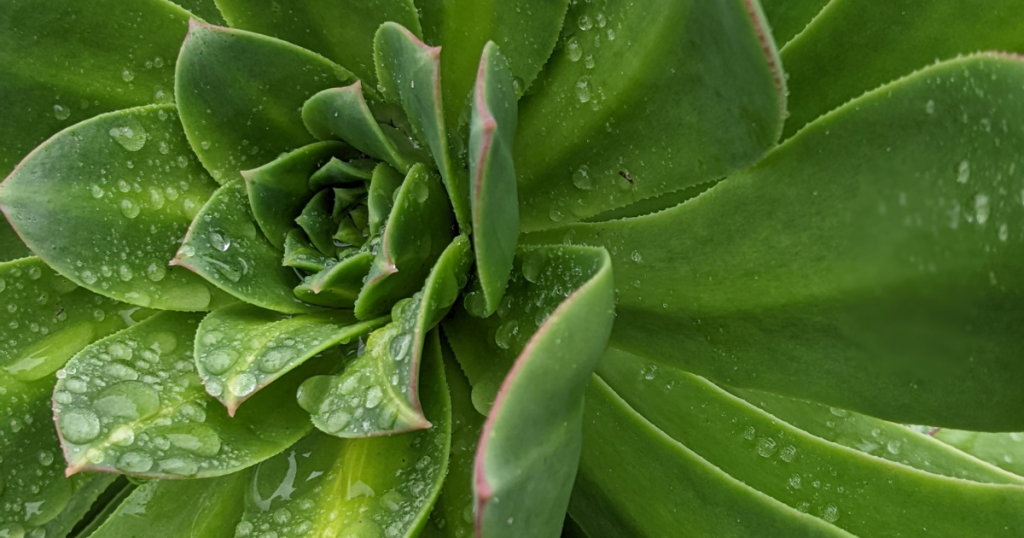
Succulents are a type of plant that is adapted to survive in environments with little moisture. However, when it comes to rain, the question of whether succulents can stay outside can be a bit more complex. In this blog post, we’ll take a closer look at the factors to consider when deciding whether to leave your succulents outside during a storm.

Rain Tolerance
Not all succulents are equally tolerant. Some succulent species are more adapted to wet environments and can withstand extended periods of exposure to wetness, while others are more sensitive and may be damaged by extended periods of downpour. It is important to research the specific care requirements of your succulent species to determine its tolerance for precipitation.

Soil Drainage
Proper soil drainage is important for the health of any plant, including succulents. Succulents that are grown in soil that does not drain well may be more prone to root rot and other problems if they are left outside. Make sure your succulents are planted in well-draining soil to help protect them from the negative effects of too much water.

There are several ways to improve the drainage of soil in the ground:
- Add organic matter: Incorporating organic matter, such as compost or well-rotted manure, into the soil can help to improve its structure and porosity. This is because organic matter helps to improve the soil’s ability to hold water and nutrients, while also increasing the number of air pockets in the soil, which allows excess water to drain away more easily.
- Improve the soil structure: If your soil is compacted or has a high clay content, it may be prone to poor aeration. In these cases, you can try to improve the soil structure by working in some inorganic coarse sand or grit to help create more air pockets and allow water to drain away more easily.
- Install a landscaping drainage system: If your soil is particularly heavy or prone to standing water, you may need to install an irrigation control system to help excess water funnel away from the root zone of your plants. This could include installing French drains, adding gravel to the soil, or building raised beds to elevate the plants above the surrounding soil.
- Choose succulents that are adapted to your soil conditions: Some plants are more tolerant of wet soil conditions than others. By choosing plants that are adapted to your soil type, you can help to ensure that they are able to thrive despite poor permeability.
- Consider heavily amending the soil before planting: If you are planning to plant in an area with poor aeration, or just live in a rainy climate, you may want to consider amending the soil before planting. This could involve adding inorganic matter, coarse sand, or grit to the soil to improve its structure and porosity.
You might like: 5 Essential Mental Health Benefits of Gardening Succulents and Cacti

Two of My Favorite Soil Amendments
Turface MVP
Turface MVP is a brand of calcined clay soil amendment that is often used to improve the porosity and structure of soil. It is made from calcined kaolin clay, which is heated to high temperatures to remove impurities and improve its physical properties.
Turface is often used in sports fields and golf courses to improve the drainage and structure of soil, and it is also used in horticulture to improve the aeration and structure of soil in container gardens and raised beds. It is particularly useful for improving the structure of heavy, clay soils, as it helps to create more air pockets in the soil and improve its ability to drain and wick water away from roots that are already soaked.
You might like: The Best Way to Water Succulents

In general, Turface is considered to be a good soil amendment for improving the aeration and structure of soil. However, it is important to note that it does not provide plants with nutrients in the same way that organic amendments do. It is primarily used to improve the physical properties of soil and prevent too much water from saturating the soil, rather than to provide nutrients to plants.
You might also like: Do succulents need sun?

If you are using Turface as a soil amendment, you may need to fertilize your plants to provide them with the nutrients they need to grow and stay healthy. If you’re interested in fertilizing, check out my post dedicated to succulent fertilizer. Although, succulents are used to being grown in soil without many nutrients so fertilizing isn’t necessary in most cases.

Turface MVP is probably my number 1 favorite soil amendment during the winter rainy season. San Diego hasn’t gotten a whole lot of consistent precipitation over the last few years, but every now and then we’ll get a few days of rain in a row. If I plan ahead and pay attention for the forecast, I’ll spread bags of Turface MVP on low lying areas in my yard and around plants that I feel might be extra sensitive to the constant rain. It helps draw that moisture into the pores of the clay and away from succulents that can’t take anymore.

In a more humid climate, it would be a great idea to heavily amend your soil with Turface MVP. You can always save a succulent that is on the dehydrated side, but when they’ve gotten too much water and are showing signs of it, it usually means succulent death is imminent.

Pumice
Pumice is a lightweight, porous volcanic rock that is often used as a soil amendment to improve drainage and aeration. It is made up of small, air-filled pores that help to create more space in the soil and improve its ability to drain.
Pumice is often used in horticulture to improve the structure of heavy, clay soils, as it helps to create more air pockets in the soil and improve its ability to drain. It is also useful for improving the drainage and structure of soil in container gardens and raised beds. Pumice is also used to keep horse stalls dry and you can find huge bags of it at your local feed and tack store under the name ‘Dry Stall’ not to be confused with ‘Stall Dry.’ I’ve only ever bought pumice this way and it works wonderfully.
In general, pumice is considered to be a good soil amendment for improving drainage and aeration. However, it is important to note that it does not provide plants with nutrients in the same way that organic amendments do. It is primarily used to improve the physical properties of soil, rather than to provide nutrients to plants. If you are using pumice as a soil amendment, you may need to fertilize your plants to provide them with the nutrients they need to grow and stay healthy.

Location
The location of your succulents can also play a role in their ability to withstand rain. Succulents that are grown in areas with good airflow and plenty of sunlight may be better able to withstand a downpour than those grown in more sheltered or shaded locations. If you are concerned about your succulents getting rained on, consider placing them in a location where they will be protected from the elements.

Does Rainwater Have Nutrients That Are Beneficial to Succulents?
Rainwater can contain trace amounts of nutrients that can benefit succulents, but it is generally not considered a significant source of nutrients for these plants. Succulents are adapted to grow in environments with low levels of available nutrients, and they generally obtain the majority of their nutrients from the soil in which they are grown.
Rainwater can be beneficial for succulents in other ways, however. It can help to keep the soil moist, which is important for the health of these plants, particularly during dry periods. Additionally, rainwater is generally free of chlorine and other chemicals that may be present in tap water, making it a good choice for watering succulents.
To ensure that your succulents receive the nutrients they need to thrive, it is generally recommended to fertilize them with a balanced fertilizer specifically formulated for succulents and cacti. This will provide the plants with the nutrients they need to grow and stay healthy.

Where to Buy Succulents Online
Conclusion
While succulents are generally adapted to survive in dry environments, they can also tolerate some exposure to rain, depending on the specific species and the conditions in which they are grown. By considering factors such as rain tolerance, soil drainage, and location, you can help ensure that your succulents stay healthy and thriving, even during rainy periods.


